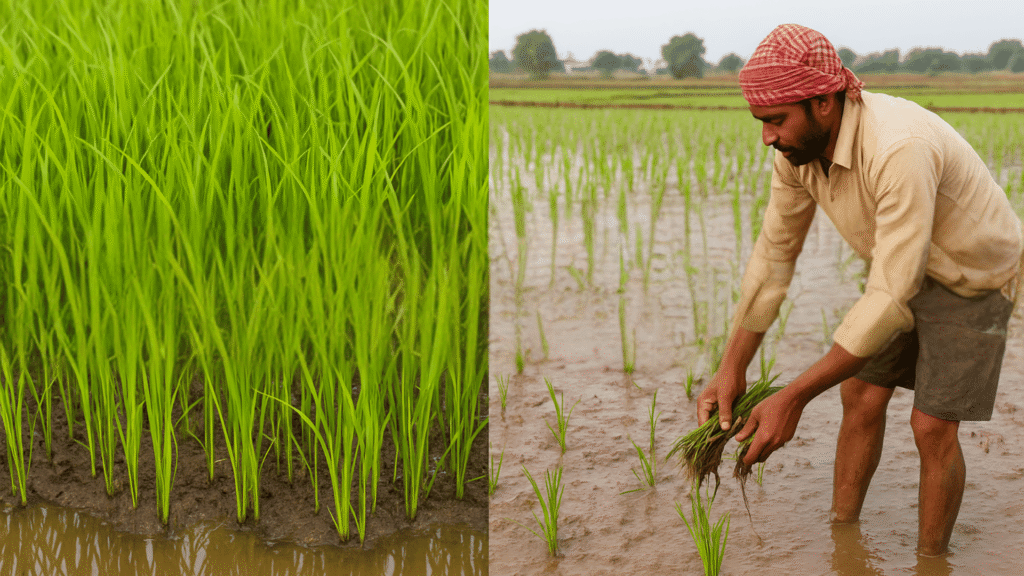
Table of Contents
ToggleIntroduction
Rice is one of the most important crops in Pakistan, especially in Punjab and Sindh where it provides livelihoods for many farmers. A strong rice nursery is essential for a healthy crop. If the nursery is weak, the rest of the crop suffers—yield decreases and grain quality suffers.
Role of Farmer Experience in Nursery Success
In rice farming, every farmer has their own set of experiences passed down from elders or learned through trial and error. These experiences play a big role in nursery management. For example, an experienced farmer often knows by touch and smell whether the soil is ready for sowing or if it needs more drying time. They can judge the right depth for sowing seeds without even measuring, just by seeing how the soil crumbles in their hand. Such skills, when combined with modern recommendations like using healthy seeds, proper fertilizer doses, and balanced watering, can greatly increase the chances of a strong and healthy rice nursery. Sharing these experiences with fellow farmers can help everyone in the community improve their results.
Why a Healthy Nursery Matters
Builds uniform strong seedlings
Boosts pest and disease resistance
Helps tillering (more stems per plant)
Sets the stage for higher yield
Choosing the Best Nursery Site
Near reliable water sources: canal, tube well
Fertile, well-tilled soil
Level, free from weeds and debris
Slightly raised to avoid waterlogging
Land Preparation
Primary Tilling — Break up soil with tractor or plough
Puddling — Flood and re-plough to create a soft bed
Leveling — Ensure even water distribution
Selecting Quality Seed
Use certified seed (Punjab Seed Corporation, private dealers)
Choose varieties suited to your region (e.g., Super Basmati, Kainat, IRRI-6)
Avoid mixing different varieties
Seed Rate per Acre
Basmati: 8–10 kg
Coarse/IRRI: 10–12 kg
Seed Treatment
Soak the seed in clean water for 24 hours, then drain and keep it in a moist cloth for another 24 hours to encourage sprouting. Avoid soaking longer than recommended, as it can damage seed vigor.
Treat with fungicide (Topsin-M, Carbendazim @ 2–3 g/kg seed) aari.punjab.gov.pkGrowTech Solutions
Sowing the Nursery
Wet Bed Method
Flood the plot to 2–3 cm depth
Broadcast uniformly pre-germinated seeds
Maintain water depth until seedlings emerge
Dry Bed Method
Prepare moist beds without flooding
Sow seeds and lightly irrigate
Ideal in water-scarce zones
Fertilizer Use in Rice Nursery
For around 1 marla (272 sq ft):
DAP: 100–120 g at sowing
Urea: 60–80 g split (at sowing + 10–12 DAS)
SOP: 50–60 g
Add well-decomposed farmyard manure
Water Management
Maintain 2–3 cm water after germination
Avoid deeper flooding in early days
Drain excess water after heavy rains
Weed Control
Hand weed at ~15 DAS
Use pre-emergence herbicide (Butachlor) if needed
Pests and Diseases of Rice Nursery
Bakanae – Caused by seed-borne fungus; treat seeds prior to sowing PMCResearchGate
Stem Borer – Apply insecticide if “dead heart” symptoms appear
Leaf Folder – Use light traps and spot spray
Transplanting of Rice Nursery
Basmati: 25–30 day-old seedlings
IRRI: 20–25 day-old
Avoid delaying transplanting beyond recommended age
Common Nursery Problems & Solutions
1. Yellowing Seedlings
Yellowing is often caused by nutrient deficiency, mainly nitrogen, or waterlogging. To fix this, apply a light dose of urea (half bag per acre) after seedlings are 10–12 days old and maintain proper water drainage.
2. Poor Germination
Poor germination happens due to low-quality seed, improper soaking, or sowing in too deep mud. Always use certified seed, soak for 24 hours, drain for 24 hours, and sow in fine tilth soil for uniform sprouting.
3. Stunted Plant Growth
Causes: Nutrient shortage, root pest damage, lack of water
Solutions: Balanced fertilizer doses, pest monitoring, maintain soil moisture
4. Lodging (Seedlings Falling Over)
Causes: Deep water, overcrowding, excess early nitrogen
Solutions: Stick to 2–3 cm water, follow seed rates, avoid extra early nitrogen
5. Fungal Diseases
Causes: Contaminated seed, dense transplanting, standing water
Solutions: Fungicide seed treatment, proper seed spacing, timely draining
Additional Nutritional Disorders
Iron deficiency: Pale leaves with green veins—apply iron chelate or foliar spray
Timely Shifting of Nursery to the Main Field
One of the most common mistakes in nursery management is delaying the transfer of seedlings to the main field. Farmers sometimes wait too long, thinking the plants will grow stronger if left in the nursery. In reality, overgrown seedlings can become weak, develop fewer tillers, and take longer to establish after transplanting. The ideal age for transplanting in most Pakistani conditions is 20–25 days for fine varieties and around 25–30 days for coarse types. Timely transplanting not only improves crop health but also helps avoid pest attacks and nutrient shortages. Keeping an eye on the seedling height and root development can guide you in choosing the perfect time for shifting.
Farmer Mistakes & Fixes
| Mistake | Effect | Fix |
|---|---|---|
| Over-sowing seed | Weak, overcrowded seedlings | Follow recommended seed rates |
| No seed treatment | Disease outbreaks | Treat all seed before sowing |
| Poor field leveling | Uneven germination | Level nursery site accurately |
| Late transplanting | Reduced tillering | Transplant on time |
| Overwatering early | Weak stems, lodging | Maintain shallow water only |
Farmer Tips for Best Results
Use certified, clean seed
Keep nursery weed-free
Split Urea dose; don’t overapply early
Protect seedlings from animals
Inspect daily for pests and diseases
Conclusion
A well-managed rice nursery is key to robust tillers, strong plants, and high yields. By following localized, practical Pakistani methods—from selecting and treating seeds to controlling yellowing and germination issues—farmers can significantly increase productivity and income.